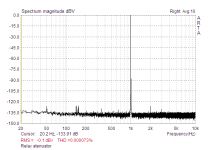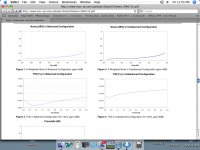Show or link please one measurement with gain setting different from 0dB for PGA..All pictures I saw was with gain 0dB (why??), at 0dB it is OK.. I used more than 200 pieces by reliable supplier, all was bad same way? I posted my own experience with it, believe or not..Well, since others got much better results using the same technology,
Last edited:
BV said:And differencies between PGA, DAC with OA in multiplying mode and relay attenuator are clearly audible and measurable, even with "ordinary" speakers.
So I'll ask one more time- do you have any data to support your assertion about "clearly audible and measurable" differences between DACs in multiplying mode and relay attenuators? Atkinson's measurements show superb performance.
Attached is one measurement for preamp with relay attenuator, difference is visible.. I organized more "sessions" and listeners always prefered version with relay attenuator against PGA or DAC regulation. Most audible are difference between PGA or WM8816 against DAC +OA,and again, DAC is superb compared to PGA or WM, difference DAC vs. relay attenuator is more subtle
Attachments
Last edited:
What are those lines near 140/160Hz? Interference intermodulation products? How does it look above 10kHz?
Measurement is with preamp conected in loopback, with desktop PC, it looks same with PC only loopback. Simply measurements artefacts, suppose from monitor . And it is calibrated in dBV..You know all other measurements (10kHz, CCIF, THDvs freq...) from "slovanet".
George,
Can you help find (you are so good at it) the hearing research on the perception limits/numbers to apply to GD measurements as thresholds/limits? We can start to use that in evrything we make as a 'pass-fail' parameter. ... Now that we have low cost means to measure it.
It is especially interesting for complete Systems evaluations on both record and playback chains. And, what does typical 'EQ' do to those parameters. How to make better EQ designs. Etc.
Thx-RNMrash
Thx-RNM
difference DAC vs. relay attenuator is more subtle
OK, so not "clearly measurable and audible."
BV said:difference DAC vs. relay attenuator is more subtle
OK, so not "clearly measurable and audible."
For trained listeners "subtle" is "clearly audible" + we all have seen BV's measurements.
Stick to your position, BV. You are showing us what is BEYOND the spec sheet. Almost all engineers know that 'full on' is the easiest position with electronic volume controls.
Well, if it is 'audible', may-be you can describe what you miss with them, or, at least, describe those 'audible' differences ?For trained listeners "subtle" is "clearly audible"
For trained listeners "subtle" is "clearly audible" + we all have seen BV's measurements.
No, we haven't. No measurement comparison of relay vs MDAC, no details on listening tests. And he's confused 0dB (no attenuation) with 0dBV in Atkinson's measurements and ignored the graph of THD versus output.
But he seems to have backed off on that aspect of his claim, which is at least honest, and for which BV should be congratulated. That stands in sharp contrast to people who make incorrect claims and when confronted with contradictory data, refuse to admit error. That transcends error (which is human) and enters into the territory of dishonesty.
Looks like a pretty nice part. Nominal impedance 10k, and you use external amplifiers. They state that the zero crossing mechanism eliminates clicks, which isn't strictly correct, but so it goes.
Everyone, please look at figs 3 and 4 on the specsheet put forth by Esperado. What I see is a distortion measurement with input level at FULL OUTPUT. Am I wrong in assuming this?
Attachments
Last edited:
George,
Can you help find
Richard
I will try.
But first I need to make certain what this “GD” stands for
1. Group Delay measurements?
2. Group Disillusions measurements?
3. God Damn measurements?
As a preliminary comment, EQ affects all three.
George
Everyone, please look at figs 3 and 4 on the specsheet put forth by Esperado. What I see is a distortion measurement with input level at FULL OUTPUT. Am I wrong in assuming this?
Yes, you are. Full gain is +15.5dB.
Stick to your position, BV. You are showing us what is BEYOND the spec sheet. Almost all engineers know that 'full on' is the easiest position with electronic volume controls.
He has worked a lot with these PGAs, so I believe his measurements. And even for him it might be useful to look what is beyond spec sheets in another cases as well 😉
What is your experience with these attenuators, PMA? I have not tested one in years, but I sure need good advice as what to look for.
Look at posted 3 pictures..MDAC, PGA and realy atenutor. Maybe here is some language barrier, but for sure I am not confused with 0dB (gain) and 0dBV (absolute level). Again, THD figures for PGA are for gain diferent (lower than) from 0dB worse, than for 0dB. This not valid for MDAC, nor relay atenuator. Try it , I tried personaly in last ten years MDAC ( a bit complicated "driving" for dB steps), WM8816, PGA2310, MAS6116 (all very covenient for use), and finally I stick with relay attenutor. It is simply sonically the best solution with best measured parameters.No measurement comparison of relay vs MDAC, no details on listening tests. And he's confused 0dB (no attenuation) with 0dBV in Atkinson's measurements
No , picture 3,4 :"THD bal/unbal, gain=0dB"..Yes, you are. Full gain is +15.5dB.
2 PMA
Do not worry, I am looking, in this and another cases, too.
Last edited:
- Status
- Not open for further replies.
- Home
- Member Areas
- The Lounge
- John Curl's Blowtorch preamplifier part II

